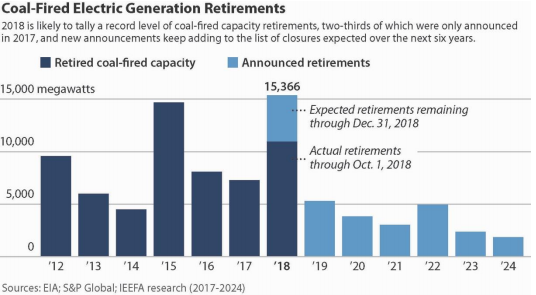According to the Energy Information Administration (EIA), U.S. electricity generation in 2018 is on pace to reach the highest level since before the economic recession in 2008 and perhaps a record high. Despite electricity demand’s recovery, coal-fired capacity retirements are expected to reach a record this year—15.4 gigawatts—exceeding the earlier record in 2015 of 14.7 gigawatts. Eleven gigawatts of coal-fired capacity have already retired, and an additional 4.37 gigawatts are expected to retire in the last three months of this year.

Electricity Generation
Electricity generation has been relatively stagnant for a decade mainly because of a slow-growing economy after the 2008 global recession. Electricity generation decreased in six of the past ten years due to declining industrial demand and relatively flat residential and commercial demand. According to the EIA’s Short-term Energy Outlook, electricity generation is expected to reach 4,160 gigawatt hours in 2018—3.6 percent higher than in 2017. In 2007, U.S. electricity generation was 4,157 gigawatt-hours.
Coal-Fired Retirements
Despite the growth in electricity generation this year, coal-fired retirements may be at a record level due to additions of gas-fired capacity and wind and solar capacity. Wind and solar generation made up 7.7 percent of U.S. generation in 2017 and they are expected to provide an 8.2 percent share this year. Natural gas-fired power plants are expected to increase their share of generation from 32 percent in 2017 to 35 percent in 2018. Five years ago, natural gas’s share was just 28 percent. EIA expects coal’s electricity generation share to drop to 28 percent in 2018—down from 30 percent in 2017.
The expected coal-fired retirements in 2018 are made up of 44 units at 22 plants in 14 states across the United States. The coal plant closures are expected to take place in Florida, Indiana, Kansas, Kentucky, Maryland, Minnesota, Missouri, Ohio, Pennsylvania, Tennessee, Texas, Virginia, West Virginia, and Wisconsin.
Further, an additional 21.4 gigawatts of coal-fired capacity are expected to close over the next six years, which will bring the total coal-fired capacity retirements between 2018 and 2024 to 36.7 gigawatts, made up of 117 units. The country’s current fleet of coal-fired power plants totaling 246 gigawatts will then be reduced by 15 percent, leaving 209 gigawatts of coal-fired capacity at the end of 2024. The United States at one time had over 300 gigawatts of coal-fired capacity, which generated over 50 percent of the nation’s power.
Natural Gas and Renewable Energy Take Over
Due to hydraulic fracturing and horizontal drilling in shale basins, natural gas prices have plummeted. Utilities are building natural gas plants because they expect natural gas prices to remain low for years and because the natural gas plants are relatively inexpensive to build and operate.
Due to favorable federal renewable subsidies and state mandates for renewable power, wind generation has been growing fast in states from Texas to North Dakota where the best wind resources are located. In four states—Iowa, Kansas, Oklahoma, and South Dakota—wind accounts for at least 30 percent of each state’s annual electric generation. As favorable wind sites are used up, solar power is meeting the state mandate requirements.
States are considering pushing up their mandates of renewable energy. For instance, Nevadans will be voting on Question 6, a proposal that would double the Renewable Portfolio Standard to 50 percent by 2030. The Nevada’s current standard is 25 percent by 2025. In Arizona, proposition 127 would annually increase Arizona’s current renewable energy standard of 15 percent by 2025 until it reaches 50 percent in 2030.
Conclusion
Coal-fired power plants are continuing to be retired and replaced with natural gas, wind, and solar plants. Removing existing generators whose capital costs are paid but are capable of producing electricity for years to come in order to build new gas, solar, and wind plants increases the rate base of regulated utilities and thereby provides them with greater earnings. But that is like destroying a perfectly good building just to erect another that provides the same or similar needs for the consumer but more earnings for the construction industry—a pretty wasteful proposition, particularly for electricity consumers.